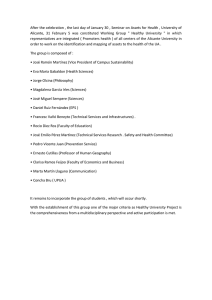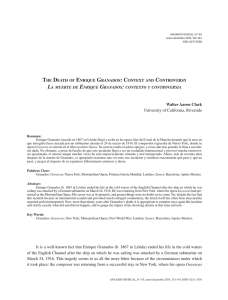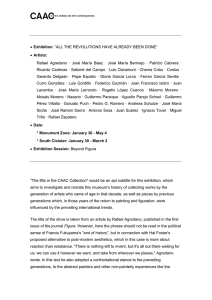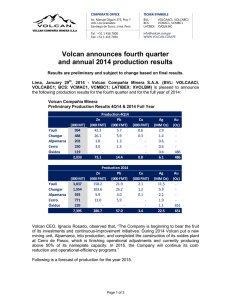Review of Virginia Gil Amate, Sueños de unidad hispánica en el
Anuncio
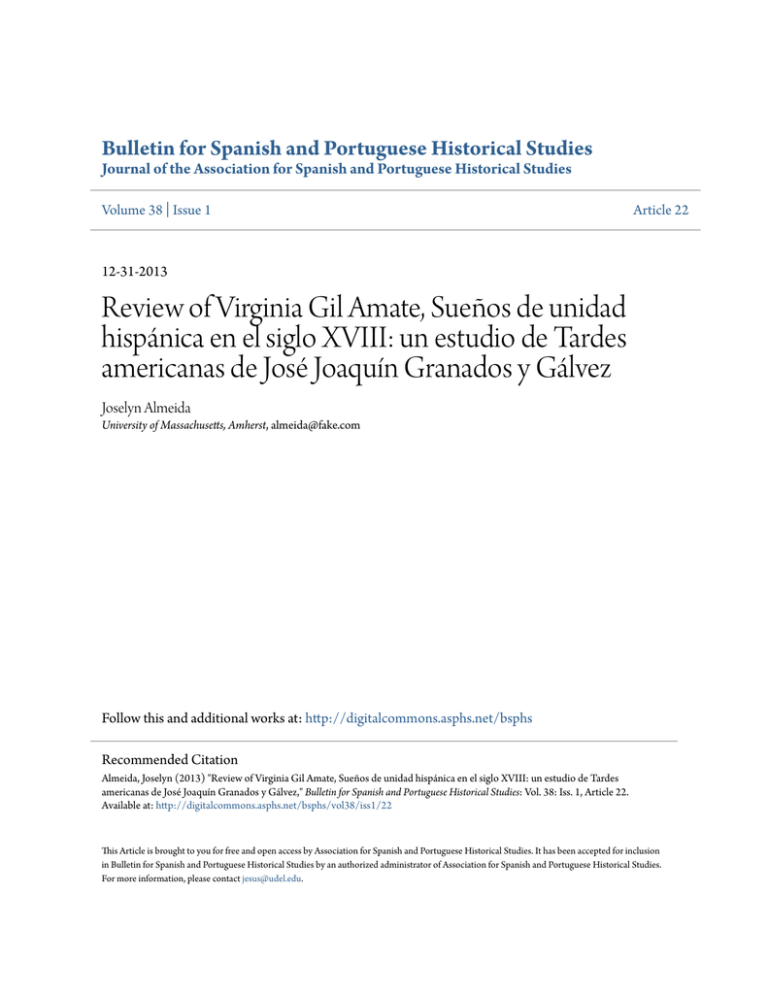
Bulletin for Spanish and Portuguese Historical Studies Journal of the Association for Spanish and Portuguese Historical Studies Volume 38 | Issue 1 Article 22 12-31-2013 Review of Virginia Gil Amate, Sueños de unidad hispánica en el siglo XVIII: un estudio de Tardes americanas de José Joaquín Granados y Gálvez Joselyn Almeida University of Massachusetts, Amherst, almeida@fake.com Follow this and additional works at: http://digitalcommons.asphs.net/bsphs Recommended Citation Almeida, Joselyn (2013) "Review of Virginia Gil Amate, Sueños de unidad hispánica en el siglo XVIII: un estudio de Tardes americanas de José Joaquín Granados y Gálvez," Bulletin for Spanish and Portuguese Historical Studies: Vol. 38: Iss. 1, Article 22. Available at: http://digitalcommons.asphs.net/bsphs/vol38/iss1/22 This Article is brought to you for free and open access by Association for Spanish and Portuguese Historical Studies. It has been accepted for inclusion in Bulletin for Spanish and Portuguese Historical Studies by an authorized administrator of Association for Spanish and Portuguese Historical Studies. For more information, please contact jesus@udel.edu. BSPHS 38:1 (2013) Virginia Gil Amate. Sueños de unidad hispánica en el siglo XVIII: un estudio de Tardes americanas de José Joaquín Granados y Gálvez. Alicante: Centro de Estudios Iberoamericanos Mario Benedetti, 2012. 280 pp. In his landmark How to Write the History of the New World (2001), Jorgue Cañizares-Esguerra brought renewed attention to José Joaquín Granados y Gálvez (1743-1788), a Franciscan priest who adumbrated what he terms a “patriotic epistemology” in the debate about the nature of America and Americans alongside authors such as Jesuit Francisco Clavijero. Cañizares-Esguerra attributes the scholarly neglect of Granados’ Tardes americanas: Gobierno gentil y católico: Breve y particular noticia de toda la historia indiana … Trabajadas por un Indio, y un Español (1778) to its generic difficulty, “it is not easily characterized” (230). While studies on Clavijero and others have proliferated in the last decade, Virgina Gil Amate provides one of the few recent monographs devoted to the Tardes americanas. Her reassessment of Granados y Gálvez attends to the generic challenges of the work, and the complexities of the author’s subject position as a Spaniard who lived most of his life in New Spain, and whose relationship to colonial government was complicated by his familial connection to José de Gálvez, then Minister of the Indies. Although historiography emerged as the battleground for the querelle d’Amerique, Gil Amate demonstrates how Granados’ choice of the genre of the dialogue allowed him to mediate between various registers of Mexican historiography to – from oral and indigenous histories to accounts of European travelers – and to navigate censorship’s waters. The characters, “Indio,” “Español,” and “Cura,” a silent witness who records the conversations, review ancient Mesoamerican history and vindicate the intellectual and spiritual capacities of indigenous Americans and Criollos in the first eight dialogues; the other nine examine the history of the conquest, analyze subsequent governmental policies of the Spanish empire, and comment on contemporary events. Granados’ characters could be taken for abstracted types who represent the positions of their class and ethnicity, yet this reading would be a simplification. The dynamics of the dialogue both as genre and process allow for greater individuation of the characters, even those modeled within Ciceronian and neoclassical constraints like the Tardes (34). The conversation between the Amerindian and the Spaniard produces a multilayered effect that results in an ironic, double-voiced text. Gil Amate writes “Esa escritura entre líneas produce un texto de dos niveles en cuanto a los asuntos que tratan materias de estado: en un estrato estaría la absoluta celebración de la política borbónica, en otro las coordenadas ideológicas de Granados, muchas 254 BSPHS 38:1 (2013) veces contraria a la acción gubernativa” (45-6). Granados is less concerned with producing the “Truth” about Mexican history than with modeling a method for synthesizing competing accounts guided by Franciscan principles and loyalty to the crown. “Su regalismo, la tradición de su orden y su origen español, lo mueven a una cerrada defensa del orbe hispánico, bajo una corona y una fe” (218). Nevertheless, this conservative ethos produces surprising radical positions, such as Granados’ advocacy of intermarriage between Spaniards, Amerindians, and Criollos to achieve greater social and political cohesion (176). Gil Amate’s analysis gestures towards the place of Africans in Mexican and American society in Granados, yet the questions raised by the Spaniard’s tracing of the genealogy of Anahuac to Africa and the Amerindian’s Vico-like refutation remain an unexplored opportunity in an otherwise comprehensive analysis. Gil Amate situates Granados in relation to Boturini, Feijoo, Juan José Eguiara y Egurén and other contemporaries to reveal how the Tardes anticipate Clavijero’s defense of indigenous culture. Yet Granados is ultimately a more Burkean than proto-revolutionary figure. If he asserts the value of America and the abilities and rights of Spain’s subjects regardless of ethnicity to partake in governmental and ecclesiastical offices, it is with the end of preserving the integrity of the empire. As she writes, the Tardes, “pone en duda la existencia de la existencia de un claro discurso criollo, extendido durante el virreinato para desembocar en la Independencia, que sería patriótico y americanista, por llevar, entre otras cosas, en su ideario básico la asunción de la cultura indígena y su defensa de la misma” (103). In the midst of epochal events such as the expulsion of the Jesuits, the U.S. War of Independence, and the troubled administration of José de Gálvez, the Tardes portray a vision of a renewed Catholic monarchy that would value indigenous American culture, mestizos, and Criollos to strengthen ties across the Hispanic world. As Gil Amate notes, by 1778 this vision belonged to the past, yet the reformist and conciliatory spirit that it dramatized prefigured the work of later writers, notably Joseph (José) Blanco White, who like Granados, chronicled the Hispanoamerican crisis from outside Spain, and deployed the form of the dialogue to address it in El Español (1810-1814). Scholars in search of connections between Granados and the heady milieu of Mexico in the late eighteenth century will find in Gil Amate’s reassessment of the Tardes americanas a welcome addition to the literature. Joselyn M. Almeida University of Massachusetts, Amherst 255
